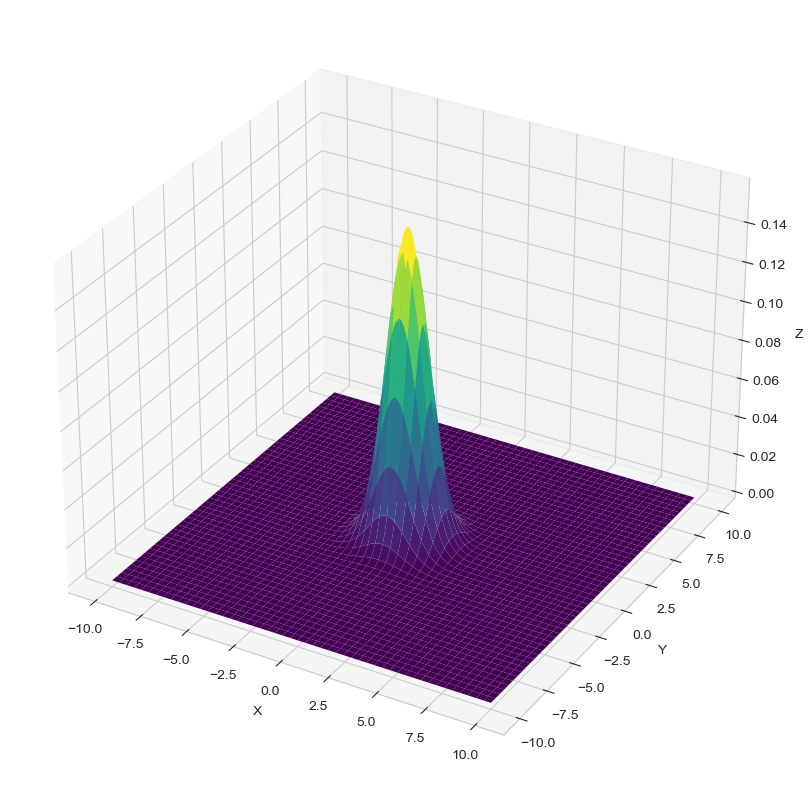Generative Models
```python import numpy as np import matplotlib.pyplot as plt import scipy as sp import seaborn as sns
import warnings
warnings.simplefilter(action='ignore', category=FutureWarning)
import numpy as np
from scipy.stats import multivariate_normal
import seaborn as sns
sns.set_style()
import matplotlib.pyplot as plt
from IPython.display import display, clear_output
# define a grid for x and y values
x = np.linspace(-10, 10, 500) # generate 500 points between -10 and 10 for x
y = np.linspace(-10, 10, 500) # generate 500 points between -10 and 10 for y
X, Y = np.meshgrid(x, y) # create a grid for (x,y) pairs
# create an empty array of the same shape as X to hold the (x, y) coordinates
pos = np.empty(X.shape + (2,))
# fill the pos array with the x and y coordinates
pos[:, :, 0] = X
pos[:, :, 1] = Y
# create a multivariate normal distribution using the defined parameters
rv = multivariate_normal(np.zeros(2,), np.eye(2))
# create a new figure for 3D plot
fig = plt.figure(figsize=(10, 20))
# add a 3D subplot to the figure
ax = fig.add_subplot(projection='3d')
# create a 3D surface plot of the multivariate normal distribution
ax.plot_surface(X, Y, rv.pdf(pos), cmap='viridis', linewidth=0)
# set labels for the axes
ax.set_xlabel('X')
ax.set_ylabel('Y')
ax.set_zlabel('Z')
# display the 3D plot
plt.show();

def data_generator(f, x: list, y: list, n: int = 1) -> tuple[np.array, np.array]:
xi = 4 * (np.random.random() - 0.5)
yi = np.random.normal(loc=f(xi), scale=1)
x.append(xi)
y.append(yi)
return np.array(x), np.array(y)
def basis_expansion(basis :tuple, x : np.array) -> np.array:
array_expanded = np.zeros((len(basis), len(x)))
for i, f in enumerate(basis):
for j, point in enumerate(x):
array_expanded[i, j] = f(point)
return array_expanded.T
def posterior_distribution(X: np.array, y: np.array, sigma: float, tau: float) -> tuple[np.array, np.array]:
n, m = X.shape
#print(X.shape, y.shape, X, y, X.T @ X)
beta = np.linalg.inv(X.T @ X + (sigma / tau)**2 * np.eye(m)) @ X.T @ y
covariance = np.linalg.inv((1 / sigma**2) * X.T @ X + (1 / tau**2) * np.eye(m))
return beta, covariance
def posterior_predictive_distribution(X: np.array, beta: np.array, sigma, covariance: np.array):
pass
def bic_score(mean: float, var: float) -> float:
n = len(x)
for d in range(1, 20):
break
x = []
y = []
f = lambda x : x**3 - x + 1
basis = (lambda x: x**0, lambda x: x**1, lambda x: x**2, lambda x: x**3)
plt.figure(figsize=(10, 6))
plt.xlabel('x')
plt.ylabel('y')
plt.title('Bayesian linear regression')
x_points = np.linspace(-1.5, 1.5)
for i in range(20):
x_array, y_array = data_generator(f, x, y)
X = basis_expansion(basis, x_array)
beta, covariance = posterior_distribution(X, y_array, 1, 1)
y_pred = basis_expansion(basis, x_points) @ beta.T
plt.plot(x_points, y_pred, color='red', alpha=0.1)
sns.scatterplot(x=x, y=y)
#sns.lineplot(np.linspace(-2, 2, 100), f(np.linspace(-2, 2, 100)), color='red')
plt.legend(['Random points', 'Original function'])
plt.show()
clear_output(wait=True)
plt.pause(1)
```python import numpy as np import matplotlib.pyplot as plt import scipy as sp import seaborn as sns
import numpy as np from scipy import stats import seaborn as sns import matplotlib.pyplot as plt from matplotlib import cm sns.set_theme()
```python import numpy as np import matplotlib.pyplot as plt import seaborn as sns
```python import numpy as np import matplotlib.pyplot as plt import seaborn as sns
```python import numpy as np import matplotlib.pyplot as plt import seaborn as sns
```python import numpy as np import matplotlib.pyplot as plt import seaborn as sns from matplotlib import cm from scipy import stats
```python import numpy as np import matplotlib.pyplot as plt from scipy import stats import seaborn as sns
```python import numpy as np import matplotlib.pyplot as plt import seaborn as sns from scipy import stats from matplotlib import cm
import numpy as np import matplotlib.pyplot as plt import seaborn as sns from scipy import stats
```python x = ‘x’ def setroomlighting(other): print(other)
```python import warnings warnings.simplefilter(action=’ignore’, category=FutureWarning)
import numpy as np from scipy import stats import seaborn as sns import matplotlib.pyplot as plt from matplotlib import cm sns.set_theme()
```python import numpy as np import matplotlib.pyplot as plt import scipy as sp import seaborn as sns
```python import numpy as np import matplotlib.pyplot as plt import seaborn as sns